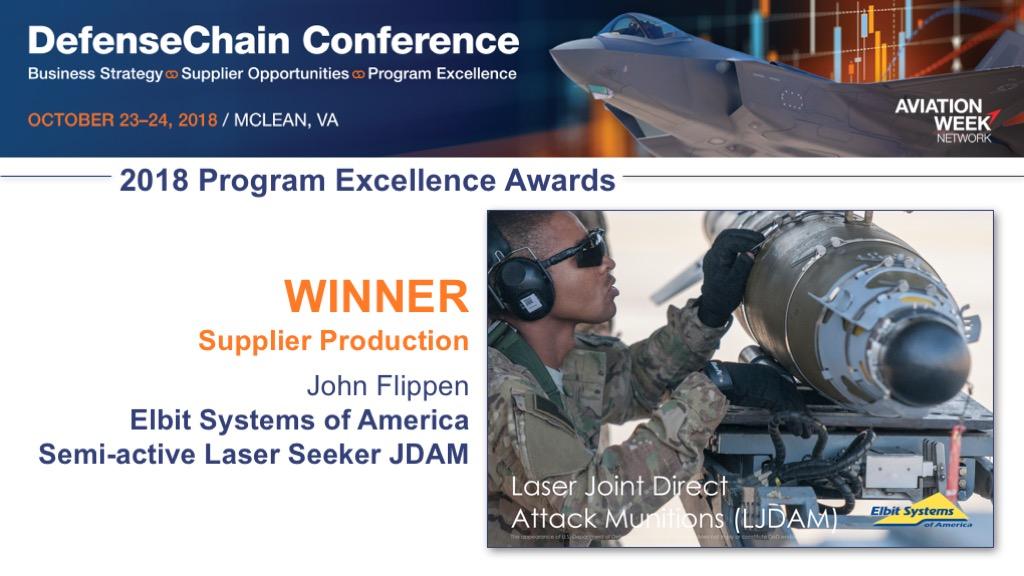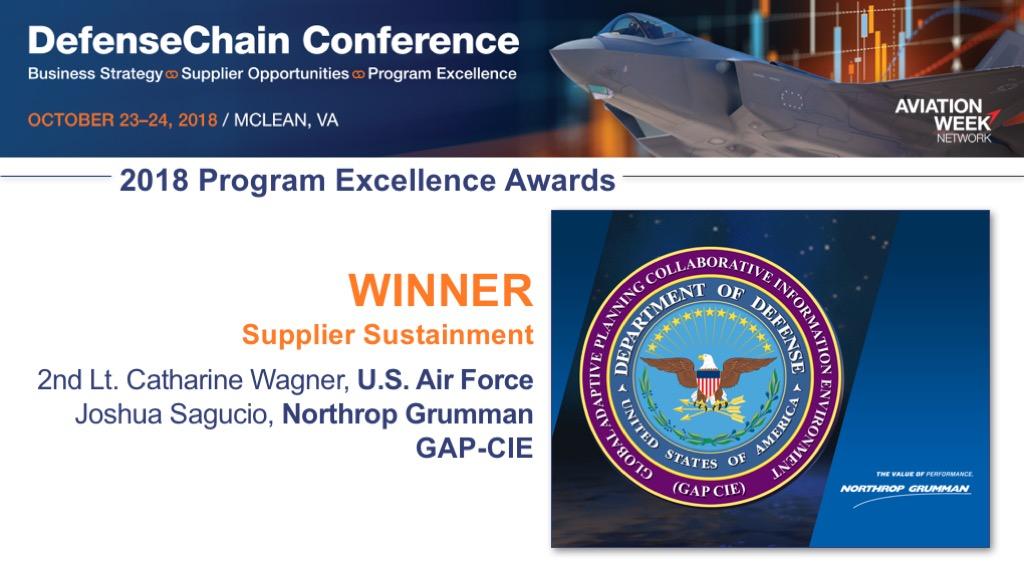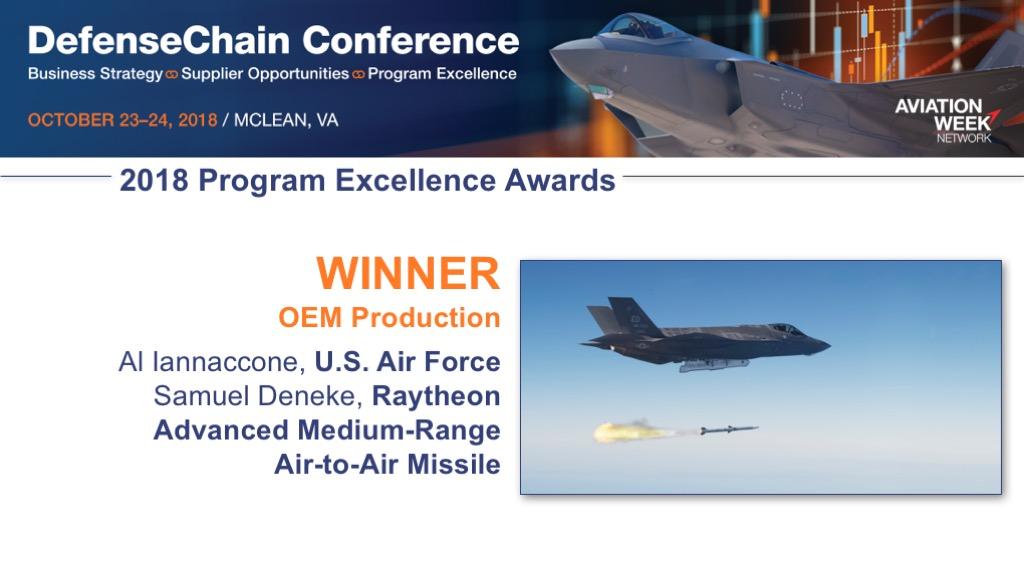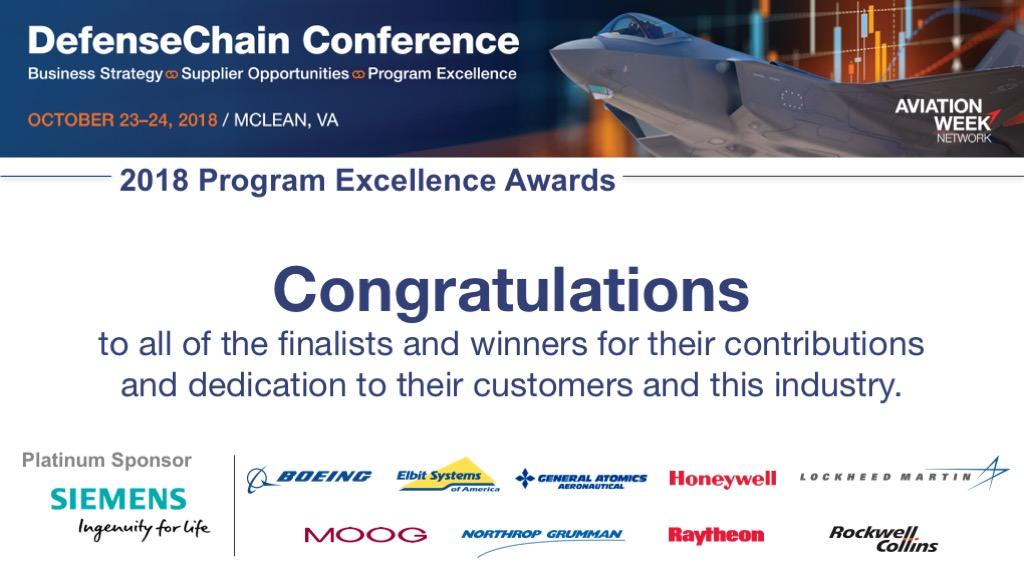
Aviation Week’s Program Excellence Awards celebrate the people who do everything in their power to stay out of the limelight and do things right, people who sign up for “extreme ownership” for program teams.

Seven Categories for Program Excellence Awards
Seven categories of awards recognize the stages of a program/product life cycle.

Special Projects Winner
F-35 Helmet-Mounted Display System, RCEVS
Known as RCEVS, the joint venture pushed this system to a new level of performance by reducing weight and improving night vision capability—both on a compressed time frame. The weight reduction means pilots weighing less than 135 lb. can use the helmet without ejection seat restrictions. The helmet’s night vision capability, which had met specifications, was improved to operate in a wider variety of conditions.

Supply Chain R&D
The Visible Infrared Imaging Radiometer Suite (VIIRS), Raytheon Co.
VIIRS is onboard the National Oceanic and Atmospheric Administration next-generation weather satellite. The system collects infrared and visible imagery in day and low-light conditions. More than 1,600 engineers contributed to the two VIIRS sensors, collecting data in 22 bands of the electromagnetic spectrum. To ensure VIIRS survives and thrives in a punishing environment, the complex instruments underwent extensive “shake and bake” testing. More than 20 unique environmental applications are proven to improve planning, protect lives and reduce the damage and costs of major weather events.

Supply Chain Production
The Semiactive Laser Seeker for the Joint Direct Attack Munition, Elbit Systems of America
Elbit Systems of America provides the laser seeker to Boeing as part of a system designed to go after fast-moving targets. To date, this team has delivered 25,000 laser seekers. To meet heavy demand, the team focuses on five major areas: accelerated transfer of knowledge, having the right people in place at the right time to support the program, processes that allow the team to adapt quickly as new technologies develop, and time line objectives from achieving contract to reaching the learning curve cost and supply chain integration.

Supply Chain Sustainment
Global Adaptive Planning-Collaborative Information Environment Program, Northrop Grumman
Known as GAP-CIE, the web-based system provides U.S. military commanders with global collaborative planning capabilities across multiple agencies in support of global missions. Since taking on the program four years ago, Northrop Grumman instituted effective Agile methodologies, created and stabilized cross-functional scrum teams and implemented continuous delivery and DevOps practices. The team operates at a production-ready state to maintain and add capabilities. And while Category 1 defects have dropped from 26 when Northrop inherited the baseline to two in the most recent software “drop,” and reworking costs have dropped a hundredfold, this team also established several firsts in terms of taking care of the people doing the work—from each team member being challenged to improve through a reading program to decompressing by staying healthy.

Original Equipment Manufacturer (OEM) Research and Development
F-15 Advanced Display Core Processor (ADCP II) Program, The Boeing Co.
Forty-eight months after full contract authorization, this team successfully executed a 1.9-million-hr. nonrecurring engineering program that produced the fastest mission computer in the world—capable of processing 87 billion instructions per second of computing throughput. Adding to the complexity were concurrent development programs for international customers to maximize design commonality while meeting unique requirements. The program also developed a new cockpit display and data concentrator box, all integrated into the F-15 with a new common mission computer running the same software. This enables cost efficiencies for all future software updates in addition to a simplified supply chain.

OEM Production
The Advanced Medium Range Air-to-Air Missile, Raytheon Co.
The Amraam air-to-air missile has been in design, testing and production for a quarter of a century and has completed more than 4,200 test shots and 10 air-to-air combat victories. By 2015, production deliveries were behind schedule and depot and warranty missile returns were lagging. Supply base constraints, affordability concerns, technical challenges and a degraded customer relationship were major concerns. But this team turned it around, with 100% on-time delivery, behavior that resulted in team efficiency and an ability to attract and keep talented team members, a 10% reduction in test hours and a 75% drop in test equipment required. Overall, there has been a 100% increase in missile production capacity.

OEM Sustainment
The F-16 Iraq Program, Lockheed Martin
Lockheed Martin created an entire F-16 ecosystem for Iraq—including new F-16s, basing and pilot training—enabling Iraq to conduct airstrikes against the so-called Islamic State militant group. Lockheed also provides logistics support, including maintenance, back-shop, and flight operations at the base in Balad, Iraq, a situation fraught with challenges, including at one point total evacuation of the team to the United Arab Emirates and a move of the program from Lockheed’s Fort Worth site to Greenville, South Carolina. The team worked diligently with suppliers, identifying more than 300 material issues that had to be dealt with as part of closing out the line and reopening it—and used an automated system to handle material receipt, inventory, issuance, return for repair, work orders and transaction history.

Fifteen years ago, members of the aerospace industry came together to do something unique—work together to improve program performance. It was important for the customers, but also for the people who work on programs day in and day out, and to the corporations who must answer for performance issues.
We realized then that programs are the heartbeat of this industry. Ideas turn into research, which in turn becomes a development program. And if the mix of need and technology meld together just right, that idea becomes a program.
